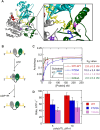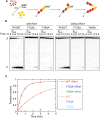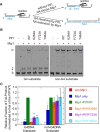Two residues in the DNA binding site of Pif1 helicase are essential for nuclear functions but dispensable for mitochondrial respiratory growth
- PMID: 38752483
- PMCID: PMC11194084
- DOI: 10.1093/nar/gkae403
Two residues in the DNA binding site of Pif1 helicase are essential for nuclear functions but dispensable for mitochondrial respiratory growth
Abstract
Pif1 helicase functions in both the nucleus and mitochondria. Pif1 tightly couples ATP hydrolysis, single-stranded DNA translocation, and duplex DNA unwinding. We investigated two Pif1 variants (F723A and T464A) that have each lost one site of interaction of the protein with the DNA substrate. Both variants exhibit minor reductions in affinity for DNA and ATP hydrolysis but have impaired DNA unwinding activity. However, these variants translocate on single-stranded DNA faster than the wildtype enzyme and can slide on the DNA substrate in an ATP-independent manner. This suggests they have lost their grip on the DNA, interfering with coupling ATP hydrolysis to translocation and unwinding. Yeast expressing these variants have increased gross chromosomal rearrangements, increased telomere length, and can overcome the lethality of dna2Δ, similar to phenotypes of yeast lacking Pif1. However, unlike pif1Δ mutants, they are viable on glycerol containing media and maintain similar mitochondrial DNA copy numbers as Pif1 wildtype. Overall, our data indicate that a tight grip of the trailing edge of the Pif1 enzyme on the DNA couples ATP hydrolysis to DNA translocation and DNA unwinding. This tight grip appears to be essential for the Pif1 nuclear functions tested but is dispensable for mitochondrial respiratory growth.
© The Author(s) 2024. Published by Oxford University Press on behalf of Nucleic Acids Research.
Figures











Similar articles
-
Yeast Pif1 helicase exhibits a one-base-pair stepping mechanism for unwinding duplex DNA.J Biol Chem. 2013 May 31;288(22):16185-95. doi: 10.1074/jbc.M113.470013. Epub 2013 Apr 17. J Biol Chem. 2013. PMID: 23596008 Free PMC article.
-
Translocation of Saccharomyces cerevisiae Pif1 helicase monomers on single-stranded DNA.Nucleic Acids Res. 2013 Apr;41(8):4613-27. doi: 10.1093/nar/gkt117. Epub 2013 Feb 27. Nucleic Acids Res. 2013. PMID: 23446274 Free PMC article.
-
Pif1 Activity is Modulated by DNA Sequence and Structure.Biochemistry. 2022 Jan 4;61(1):10-20. doi: 10.1021/acs.biochem.1c00614. Epub 2021 Dec 21. Biochemistry. 2022. PMID: 34932305 Free PMC article.
-
Dynamic regulation of Pif1 acetylation is crucial to the maintenance of genome stability.Curr Genet. 2021 Feb;67(1):85-92. doi: 10.1007/s00294-020-01116-5. Epub 2020 Oct 20. Curr Genet. 2021. PMID: 33079209 Free PMC article. Review.
-
Yeast Genome Maintenance by the Multifunctional PIF1 DNA Helicase Family.Genes (Basel). 2020 Feb 20;11(2):224. doi: 10.3390/genes11020224. Genes (Basel). 2020. PMID: 32093266 Free PMC article. Review.
Cited by
-
Eukaryotic Pif1 helicase unwinds G-quadruplex and dsDNA using a conserved wedge.Nat Commun. 2024 Jul 19;15(1):6104. doi: 10.1038/s41467-024-50575-8. Nat Commun. 2024. PMID: 39030241 Free PMC article.
References
MeSH terms
Substances
Grants and funding
LinkOut - more resources
Full Text Sources

